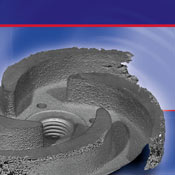United States
Canada
- Europe
Netherlands
Germany
- Africa
- Rest of World

WHAT DAMAGE DOES CAVITATION CAUSE? The damage due to cavitation can range from minor pitting to a total breach of the inside of the pump. Some people describe the damage as looking like Swiss cheese or as if "iron worms" have attacked it. As evidenced by the pictures, severe cavitation destroys the parts it contacts.
Cavitation damage can also reduce performance. Additionally, air pockets in the impeller can cause considerable hydraulic imbalance and resulting vibration. As the impeller is eroded, the uneven wear may cause further imbalance and vibration.
While Gorman-Rupp pumps are engineered to handle the deflection and loads created by cavitation, prolonged operation in this condition could eventually lead to bearing and/or shaft failure.
It is important to correct cavitation problems quickly before physical damage occurs.
HOW TO CORRECT CAVITATION It is important to properly design the pumping system. (See the suggested procedure for calculating NPSH to avoid suction cavitation. Always calculate the total dynamic head to be within the operating range of the pump.) Correcting cavitation can be difficult if not impossible to do in an existing system.
To correct discharge cavitation (operating on the far left side of the curve) may require reducing the head or increasing the flow of the pump. Changing to a higher or lower speed may help in some cases, but a system head curve must be plotted to know the correct solution before corrective action is taken. The pump must be brought back inside its operating range.
Suction cavitation is caused by an NPSH problem. A vacuum gauge will indicate a high vacuum, not the source of that high vacuum. The cause of the high vacuum needs to be identified.
A plugged suction line should always be cleaned, not blown back to the liquid source. It will just come back to plug the line again. If the suction lift is too high the pump should be moved closer to the liquid or the liquid moved closer to the pump by raising the sump level. Suction lines that are too long or too small need to be shortened and/or enlarged.
Definitions
Atmospheric Pressure - 14.7 PSI or 33.9' of water under standard conditions at sea level.
Ambient Temperature - The normal temperature at any given location at a given time. When figuring NPSH it is the temperature of the liquid.
Vapor Pressure - The pressure at which a liquid will begin to vaporize. This pressure is relative to the temperature of the liquid.
Implosion - To collapse or burst inward.